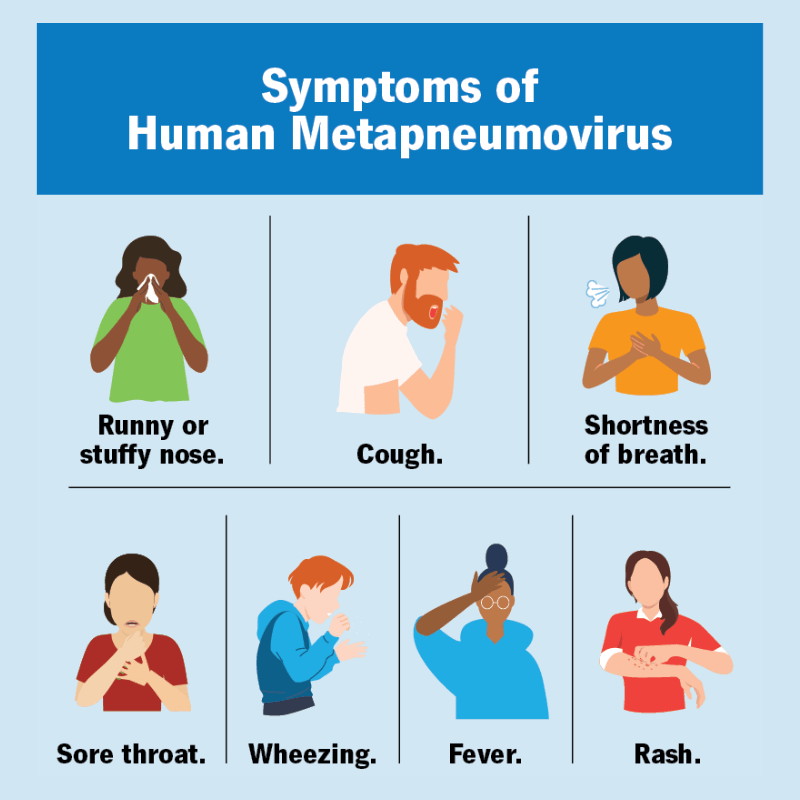
Human Metapneumovirus (HMPV) is a respiratory virus that primarily affects the respiratory tract. It was first identified in 2001 in the Netherlands and is a significant cause of respiratory illnesses, particularly in children, older adults, and immunocompromised individuals. Read here to learn more.
Human metapneumovirus (HMPV) is suddenly making headlines with media reports claiming the emergence of a “new dangerous virus” supposedly originating from China and spreading across India and the world.
However, the sharp rise in acute respiratory diseases is not unusual during this time of year according to Chinese officials
While the World Health Organization and the U.S. Centers for Disease Control and Prevention have not raised a red flag so far and there is almost nil reporting in the international media, the Indian media is awash with reports of an HMPV “outbreak” in China.
Key Characteristics of Human Metapneumovirus (HMPV)
- Family: This belongs to the Paramyxoviridae family, which includes respiratory syncytial virus (RSV) and parainfluenza viruses.
- Genetic Structure: It is a single-stranded, negative-sense RNA virus.
- Transmission: Spreads through respiratory droplets, close contact with infected individuals, or contaminated surfaces.
Symptoms of HMPV Infection

HMPV can cause various respiratory illnesses, from mild cold-like symptoms to severe lower respiratory tract infections.
- Mild Symptoms
- Runny nose
- Cough
- Sore throat
- Fever
- Severe Symptoms
- Bronchiolitis
- Pneumonia
- Difficulty breathing
- Wheezing
Populations at Risk
- Children: Common cause of respiratory illnesses in young children, often second to RSV.
- Elderly: Increased risk of severe infections, especially with underlying health conditions.
- Immunocompromised Individuals: More susceptible to prolonged or severe illness.
Diagnosis
- Laboratory Tests
- RT-PCR: Gold standard for detecting hMPV RNA in respiratory samples.
- Antigen Tests: Less sensitive but used in some clinical settings.
- Serological Tests: To identify past infections.
Treatment
There is no specific antiviral treatment for Human metapneumovirus (HMPV). Management is supportive and focuses on symptom relief:
- Mild Cases: Rest, hydration, and over-the-counter medications for fever and pain.
- Severe Cases: Oxygen therapy, mechanical ventilation, or hospitalization if necessary.
Prevention
- Hygiene Measures
- Regular handwashing.
- Avoiding close contact with sick individuals.
- Disinfecting commonly touched surfaces.
- Vaccination: There is no approved vaccine for HMPV, though research is ongoing.
- Public Health Measures: Similar strategies to those for preventing other respiratory viruses, like RSV and influenza.
Global Impact of Human Metapneumovirus (HMPV)
- HMPV infections are most common during late winter and spring, similar to RSV.
- Significant burden on healthcare systems due to hospitalizations, particularly in pediatric and geriatric populations.
- It accounts for 3%-10% of hospitalizations and 1% of lower respiratory infection-related deaths in children under five globally.
- Disproportionately affects children in low-income countries, where access to healthcare is limited.
Research and Future Directions
- Vaccine Development: Focused on preventing severe infections in high-risk groups.
- Antiviral Therapies: Targeting hMPV-specific proteins to limit viral replication.
- Epidemiological Studies: Understanding seasonal patterns and global distribution.
Key Concerns of Recent Surge
- Global Impact of Human Metapneumovirus (HMPV)
- Prevalence: Accounts for 3%-10% of hospital admissions and 1% of respiratory infection-related deaths in children under five.
- Vulnerable Groups: Children younger than six months in low- and lower-middle-income countries face the highest risk of severe outcomes.
- China’s Example
- The detection of numerous cases among children under 14 in China demonstrates the benefits of heightened surveillance and diagnostic capability.
- India’s Situation
- Inadequate Diagnostics: India lacks affordable and widely available diagnostic tests for HMPV.
- Limited Testing: Until recently, HMPV testing was confined to ICMR laboratories, though the situation is changing with the expansion of testing facilities.
- Fatality and Public Health Burden: Fatality of 1% in children under five necessitates routine HMPV testing in patients with acute respiratory disease.
Recommendations for India
- Strengthen Diagnostic Capabilities:
- Develop and distribute inexpensive, rapid diagnostic kits for Human metapneumovirus (HMPV).
- Expand laboratory networks to include state-level and district-level facilities.
- Enhance Surveillance:
- Integrate routine HMPV testing in cases of acute respiratory illness.
- Establish a national database for respiratory infections to monitor trends and outbreaks.
- Regulatory Framework:
- Introduce a fast-track approval process for diagnostic tests during outbreaks.
- Public Health Interventions:
- Focus on awareness campaigns targeting healthcare workers and the public.
- Provide supportive care facilities for at-risk populations, including children and the elderly.
- Global Collaboration:
- Partner with international health agencies to adopt best practices for HMPV control and prevention.
Conclusion
India’s limited diagnostic capacity for Human metapneumovirus (HMPV) reflects a broader challenge in addressing emerging infectious diseases. Strengthening surveillance, diagnostic capacity, and regulatory frameworks will be critical not only for managing HMPV but also for mitigating future respiratory disease outbreaks. Adopting a proactive approach will ensure better preparedness and outcomes for public health.
Human Metapneumovirus is an important pathogen in respiratory health, and continued research is vital for improving prevention and treatment strategies.
Frequently Asked Questions (FAQs)
Q. Does Human metapneumovirus (HMPV) cause serious health issues?
Ans: Most HMPV infections are mild, resembling bouts of the common cold. But severe cases can result in bronchitis or pneumonia, particularly among infants, older adults and immunocompromised people.
Q. Is HMPV the common cold?
Ans: Human metapneumovirus (hMPV) is a common respiratory virus that causes an upper respiratory infection (like a cold). It is a seasonal disease that usually occurs in the winter and early spring, similar to RSV and the flu.
Q. How long does HMPV last for?
Ans: HMPV usually causes symptoms similar to the common cold that lasts roughly 2-5 days and goes away on its own. Most children who get infected with hMPV are age 5 or younger. A small number of children (5-16%) infected will develop a lower respiratory tract infection such as pneumonia.
Related articles:
- Coronavirus (COVID-19)
- Chandipura Virus
- H3N2 Influenza Virus
- Nipah Virus
- Diseases caused by microorganisms
-Article by Swathi Satish






Leave a Reply